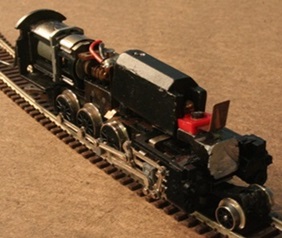Here's my completed model of a Pennsylvania Railroad Class I1s 2-10-0.
This was one of the most involved kitbash projects I've ever undertaken. As mentioned previously on this blog, there's a huge dearth of Pennsy steam available in N Scale. In fact unless you want to spend a fortune on brass, your options are: the Minitrix K4 pacific, the Minitrix B6 0-6-0, the Minitrix 2-10-0 (which requires a good bit of kitbashing) the Bachmann 0-4-0 and the ultra rare Black River E6 Atlantic. Anyway, on to the blow-by-blow.
I started out with a Minitrix 2-10-0 (More about that locomotive here: [
Link]).
First I modified the hell out of the chassis so I could slide the shell
backwards and make the steam pipes line up with the cylinders.
 |
| The modified Chassis and pilot truck. |
Next,
I cut the pilot off and added a piece of styrene between it and the
rest of the shell. I made the two front air tanks from styrene rods,
which I chucked in my electric drill and ground against a jeweler's file
to get the rounded ends. The pipe connecting the tanks is actually a
very short piece of wire.
I painted most of the shell Floquil
"Brunswick Green," the cab roof Floquil "Tuscan" and the smokebox
Floquil "Graphite." The tender shell was already painted in the correct
colors as it was a leftover from another project.
I swapped the
stock tender for a Bachmann USRA Medium-distance tender, which not only
more closely matches the prototype, it also has 8-wheel pickup. A common
malody among all three Mintirix steamers is poor power pickup and
adding the 8-wheel pickup to the tender does wonders for their
performance.
The "Pennsylvania" decals on the tender is from Microscale and the cab numbers are Woodland Scenics dry transfers.
After
that was done, I sprayed the tender and engine shells with Testors
Dulcote and used various shades of gray pastels for weathering.
All in all this project was intense. It took me about 2 months of working on and off to complete.
Addendum:
This locomotive has since been sold, ironically to finance the purchase of a brass I1. See you in about three years!













